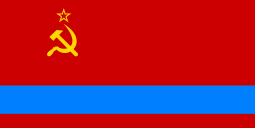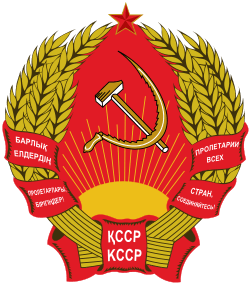Kazakh Soviet Socialist Republic
| Kazakh Soviet Socialist Republic (1936-91) Казахская Советская Социалистическая Республика Қазақ Кеңестік Социалистік Республикасы Republic of Kazakhstan (1991-95) | ||||||||||||
| Республика Казахстан Қазақстан Республикасы | ||||||||||||
| Soviet Socialist Republic (1936-91) De facto sovereign entity (1990–91) Sovereign state (1991-95) | ||||||||||||
| ||||||||||||
| ||||||||||||
| Motto Барлық елдердің пролетарлары, бірігіңдер! (Kazakh) Barlıq elderdiñ proletarları, birigiñder! (transliteration) "Workers of all nations, unite!" | ||||||||||||
| Anthem Қазақ Советтiк Социалистік Республикасының мемлекеттік әнұраны Qazaq Sovettik Socïalïstik Respuwblïkasınıñ memlekettik änuranı "Anthem of the Kazakh Soviet Socialist Republic" (1936-1992) Қазақстан Республикасының Мемлекеттік Әнұраны Qazaqstan Respuwblïkasınıñ Memlekettik Änuranı Anthem of the Republic of Kazakhstan" (1992-1995) | ||||||||||||
 Location of the Kazakh SSR (red) within the Soviet Union. | ||||||||||||
| Capital | Alma-Ata (Almaty from 1993) | |||||||||||
| Languages | Official languages: Kazakh · Russian Minority languages: Uzbek · Uyghur · Tatar · Kyrgyz · Azerbaijani · Korean | |||||||||||
| Demonym | Kazakh Soviet | |||||||||||
| Government | Unitary Marxist-Leninist one-party soviet republic (1936-1990) Unitary Marxist-Leninist presidential republic (1990-1995) | |||||||||||
| First Secretary | ||||||||||||
| • | 1936–1938 | Levon Mirzoyan | ||||||||||
| • | 1990–1995 | Nursultan Nazarbayev | ||||||||||
| Head of government | ||||||||||||
| • | 1946–1954 | Nurtas Undasynov | ||||||||||
| • | 1989–1991 | Uzakbay Karamanov | ||||||||||
| History | ||||||||||||
| • | Elevation to an Union Republic | 5 December 1936 | ||||||||||
| • | Sovereignty declared | 25 October 1990 | ||||||||||
| • | Renamed Republic of Kazakhstan | 10 December 1991 | ||||||||||
| • | Independence declared | 16 December 1991 | ||||||||||
| • | Independence recognized | 26 December 1991 | ||||||||||
| • | New Constitution | 30 August 1995 | ||||||||||
| Area | ||||||||||||
| • | 1990 | 2,717,300 km² (1,049,155 sq mi) | ||||||||||
| Population | ||||||||||||
| • | 1990 est. | 16,711,900 | ||||||||||
| Density | 6.2 /km² (15.9 /sq mi) | |||||||||||
| Calling code | +7 31/32/330/33622 | |||||||||||
| ||||||||||||
| Today part of | | |||||||||||
| Eastern Bloc |
|---|
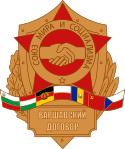 |
|
Allied states |
|
Dissent and opposition 1953 uprisings
1956 protests
|
Part of a series on the |
||||||||||||||||||||
|---|---|---|---|---|---|---|---|---|---|---|---|---|---|---|---|---|---|---|---|---|
| History of Kazakhstan | ||||||||||||||||||||
 | ||||||||||||||||||||
| Ancient | ||||||||||||||||||||
|
||||||||||||||||||||
| Khanates | ||||||||||||||||||||
|
||||||||||||||||||||
| Colonization and post-nomadic period | ||||||||||||||||||||
|
||||||||||||||||||||
| Republic of Kazakhstan | ||||||||||||||||||||
|
||||||||||||||||||||
| Topics | ||||||||||||||||||||
|
| ||||||||||||||||||||
Kazakhstan (US ![]() i/kæzækˈstæn, ˌkɑːzɑːkˈstɑːn/, UK /ˌkæzəkˈstɑːn, -ˈstæn/;[1] Kazakh: Қазақстан, Qazaqstan), officially the Kazakh Soviet Socialist Republic (Kazakh SSR or KSSR; Kazakh: Қазақ Кеңестік Социалистік Республикасы, Qazaq Keñestik Socïalïstik Respwblïkası; Russian: Казахская Советская Социалистическая Республика, Kazakhskaya Sovetskaya Sotsialisticheskaya Respublika) and the Republic of Kazakhstan, also known by its alternative name of Soviet Kazakhstan, was one of the transcontinental constituent republics of the Soviet Union from 1936 to 1991 and an sovereign state from 1991 to 1995 in northern Central Asia. It was created on December 5, 1936 from the Kazakh ASSR, an autonomous republic of the Russian SFSR.
i/kæzækˈstæn, ˌkɑːzɑːkˈstɑːn/, UK /ˌkæzəkˈstɑːn, -ˈstæn/;[1] Kazakh: Қазақстан, Qazaqstan), officially the Kazakh Soviet Socialist Republic (Kazakh SSR or KSSR; Kazakh: Қазақ Кеңестік Социалистік Республикасы, Qazaq Keñestik Socïalïstik Respwblïkası; Russian: Казахская Советская Социалистическая Республика, Kazakhskaya Sovetskaya Sotsialisticheskaya Respublika) and the Republic of Kazakhstan, also known by its alternative name of Soviet Kazakhstan, was one of the transcontinental constituent republics of the Soviet Union from 1936 to 1991 and an sovereign state from 1991 to 1995 in northern Central Asia. It was created on December 5, 1936 from the Kazakh ASSR, an autonomous republic of the Russian SFSR.
At 2,717,300 square kilometres (1,049,200 sq mi) in area, it was the second largest republic in the USSR, after the Russian SFSR. Its capital was Alma-Ata (today known as Almaty). Today it is the independent state of Kazakhstan in Central Asia. During its existence as a Soviet republic it was led by the Communist Party of the Kazakh SSR.
On October 25, 1990, the Supreme Soviet of the Kazakh SSR declared its sovereignty on its soil. Nursultan Nazarbayev was elected as president – a role he has remained in to this day.
The Soviet republic was renamed the Republic of Kazakhstan on December 10, 1991, which declared its independence six days later, on December 16, 1991. The Soviet Union was disbanded on December 26, 1991 by the Soviet of Nationalities. The Republic of Kazakhstan, the legal successor to the Kazakh SSR, was admitted to the United Nations on March 2, 1992. After the adoption of the new constitution, the state ceased to exist on August 30, 1995.
Name
The country is named after the Kazakh people, Turkic-speaking former nomads who sustained a powerful khanate in the region before Russian and then Soviet domination. The Soviet Union's spaceport, now known as the Baikonur Cosmodrome, was located in this republic at Tyuratam, and the secret town of Leninsk (now known as Baikonur) was constructed to accommodate its personnel.
History
Established on August 26, 1920, it was initially called Kirghiz ASSR (Kirghiz Autonomous Soviet Socialist Republic) and was a part of the Russian SFSR. On April 15–19, 1925, it was renamed Kazak ASSR (subsequently Kazakh ASSR) and on December 5, 1936 it was elevated to the status of a Union-level republic, Kazakh Soviet Socialist Republic.
Between 1932 and 1933, a famine struck Kazakhstan, killing 1.5 million people during the catastrophe of whom 1.3 million were ethnic Kazakhs.
During the 1950s and 1960s Soviet citizens were urged to settle in the Virgin Lands of the Kazakh Soviet Socialist Republic. The influx of immigrants, mostly Russians, skewed the ethnic mixture and enabled non-Kazakhs to outnumber natives. As a result, the use of the Kazakh language declined but has started to pick up again since independence, both as a result of its resurging popularity in law and business and the growing proportion of Kazakhs. The other nationalities included Ukrainians, Germans, Jews, Belarusians, Koreans and others; Germans at the time of independence formed about 8% of the population, the largest concentration of Germans in the entire Soviet Union. Independence has caused many of these newcomers to emigrate.
Following the dismissal of Dinmukhamed Konayev, the First Secretary of the Communist Party of Kazakhstan by the last Soviet leader, Mikhail Gorbachev, the riots broke out for four days between December 16 to December 19, 1986 known as Jeltoqsan by student demonstrators in Brezhnev Square in its capital, Alma-Ata. Only 168-200 civilians were killed or executed. The events were then spilled over to Shymkent, Pavlodar, Karaganda and Taldykorgan.
On March 25, 1990, Kazakhstan held its first elections with Nursultan Nazarbayev, the chairman of the Supreme Soviet was elected as its first president. Later that year on October 25, it then declared sovereignty. The republic participated in a referendum to preserve the union in a different entity with 94.1% voted in favor. It did not happened when hardline communists in Moscow took control of the government in August. Nazarbayev then condemned the failed coup.
As a result of those events, the Kazakh SSR was renamed to the Republic of Kazakhstan on December 10, 1991. It became independent on December 16 (the fifth anniversary of Jeltosqan), becoming the last republic to secede. Its capital was the site of the Alma-Ata Protocol on December 21, 1991 that dissolved the Soviet Union and formed the Commonwealth of Independent States in its place which Kazakhstan joined. The Soviet Union officially ceased to exist as a sovereign state on December 26, 1991 and Kazakhstan became an internationally recognized independent state although the country used the 1978 Constitution which remained in effect after its dissolution.
Emphasis was on converting the country's economy to a market economy while political reforms lagged behind achievements in the economy. By 2006, Kazakhstan generated 60% of the GDP of Central Asia, primarily through its oil industry.[2]
On August 30, 1995, the new Constitution of Kazakhstan was officially adopted. In 1997, the government moved its capital from Almaty, Kazakhstan's largest city, where it had been established under the Soviet Union, to Akmola, which was renamed to Astana in 1998.
Demographics
Population
According to the 1897 census, the earliest census taken in the region, Kazakhs constituted 81.7% of the total population (3,392,751 people) within the territory of contemporary Kazakhstan. The Russian population in Kazakhstan was 454,402, or 10.95% of total population; there were 79,573 Ukrainians (1.91%); 55,984 Tatars (1.34%); 55,815 Uyghurs (1.34%); 29,564 Uzbeks (0.7%); 11,911 Mordovans (0.28%); 4,888 Dungan (0.11%); 2,883 Turkmen; 2,613 Germans; 2,528 Bashkir; 1,651 Jews; and 1,254 Poles.

| Nationality | 1926 | 1939 | 1959 | 1970 | 1979 | 1989 |
|---|---|---|---|---|---|---|
| Kazakh | 58.5 | 37.8 | 30.0 | 32.6 | 36.0 | 40.1 |
| Russian | 18.0 | 40.2 | 42.7 | 42.4 | 40.8 | 37.4 |
| Ukrainian | 13.88 | 10.7 | 8.2 | 7.2 | 6.1 | 5.4 |
| Belarusian | 0.51 | 1.2 | 1.5 | 1.2 | 1.1 | 0.8 |
| German | 0.82 | 1.50 | 7.1 | 6.6 | 6.1 | 5.8 |
| Tatar | 1.29 | 1.76 | 2.1 | 2.2 | 2.1 | 2.0 |
| Uzbek | 2.09 | 1.96 | 1.5 | 1.7 | 1.8 | 2.0 |
| Uyghur | 1.01 | 0.58 | 0.6 | 0.9 | 1.0 | 1.1 |
| Korean | 0.8 | 0.6 | 0.6 | 0.6 |
Table: Ethnic Composition of Kazakhstan (census data)[3]
Famines
One of the greatest factors that shaped the ethnic composition of Kazakhstan was 1920s and 1930s famines, caused by Collectivization in the Soviet Union. According to different estimates only in famine of 1930s, up to 40% of Kazakhs (indigenous ethnic group) either died of starvation or fled the territory.[4] Official government census data report the contraction of Kazakh population from 3.6 million in 1926, to 2.3 million in 1939.
Culture
Before the Russian colonization, the Kazakhs had a highly developed culture based on their nomadic pastoral economy. Islam was introduced into the region with the arrival of the Arabs in the 8th century. It initially took hold in the southern parts of Turkestan and spread northward.[6] The Samanids helped the religion take root through zealous missionary work. The Golden Horde further propagated Islam amongst the tribes in the region during the 14th century.[7]
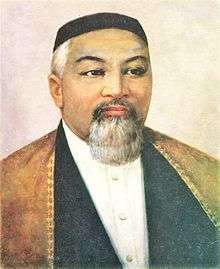
Because livestock was central to the Kazakhs' traditional lifestyle, most of their nomadic practices and customs relate in some way to livestock. Kazakhs have historically been very passionate about horse-riding.
Kazakhstan consisted a number of prominent contributors to literature, science and philosophy: Abay Qunanbayuli, Mukhtar Auezov, Gabit Musirepov, Kanysh Satpayev, Mukhtar Shakhanov, Saken Seyfullin, Jambyl Jabayev, among many others.
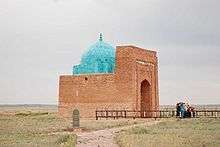
Cuisine
In the national cuisine, livestock meat can be cooked in a variety of ways and is usually served with a wide assortment of traditional bread products. Refreshments often include black tea and traditional milk-derived drinks such as ayran, shubat and kymyz. A traditional Kazakh dinner involves a multitude of appetisers on the table, followed by a soup and one or two main courses such as pilaf and beshbarmak. They also drink their national beverage, which consists of fermented mare's milk. In addition, Russian cuisine has prominence such as Chicken Kiev, Okroshka and Zakuski.
Public holidays
Like all other Soviet republics, Kazakhstan celebrated New Year's Day, Red Army Day, May Day, Victory Day and the Great October Socialist Revolution. After independence, the country now observes Eastern Orthodox Christmas, Nauryz Meyramy, Qurban Ay, and Kazakh Independence Day alongside with some of the former Soviet holidays.
Post-independence symbols
-

Coat of arms adopted in June 1992.
-

Flag adopted in June 1992.
References
- ↑ Jones, Daniel (2003) [1917], Peter Roach, James Hartmann and Jane Setter, eds., English Pronouncing Dictionary, Cambridge: Cambridge University Press, ISBN 3-12-539683-2
- ↑ Zarakhovich, Yuri (27 September 2006). "Kazakhstan Comes on Strong". Time. Retrieved 13 December 2015.
- ↑ Archived March 11, 2012, at the Wayback Machine.
- ↑ Валерий Михайлов: Во время голода в Казахстане погибло 40 процентов населения
- ↑ Wagenhauser, Betsy. "The Customs and Traditions of the Kazakh". Embassy of the Republic of Kazakhstan.
- ↑ Atabaki, Touraj. Central Asia and the Caucasus: transnationalism and diaspora, pg. 24
- ↑ Ibn Athir, volume 8, pg. 396
External links
- Kazakhstan: Seven Year Plan for Prosperity by Dinmukhamed Konayev, a 1958 Soviet propaganda booklet
